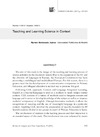Identificador persistente para citar o vincular este elemento:
https://accedacris.ulpgc.es/jspui/handle/10553/12256
| Campo DC | Valor | idioma |
|---|---|---|
| dc.contributor.author | Maldonado Juárez, Myriam | en_US |
| dc.date.accessioned | 2014-10-01T02:30:44Z | - |
| dc.date.accessioned | 2018-03-15T14:28:10Z | - |
| dc.date.available | 2014-10-01T02:30:44Z | - |
| dc.date.available | 2018-03-15T14:28:10Z | - |
| dc.date.issued | 2013 | en_US |
| dc.identifier.issn | 1133-1127 | en_US |
| dc.identifier.uri | https://accedacris.ulpgc.es/handle/10553/12256 | - |
| dc.description.abstract | The aim of this study is the design of the teaching and learning process of science activities on the circulatory system. Due to the expansion of the EU and the diversity of languages in Europe, the European Commission has been promoting a multilingual and multicultural Europe. For this reason, there is a greater need for the development of communicative competence in Primary Education, and bilingual education is an ideal way to promote this goal. Following CLIL approach, Content and Language Integrated Learning, English as a Second Language is used as a medium to teach subject matter content. CLIL consists of a variety of methods used to integrate content and language and it serves to develop knowledge of the subject as well as to improvestudents’ competency in English. Through innovative methods, it allows therecognition of meaning and the use of meaningful language in a particularcontext. Applying CLIL involved the preparation of specific materials for 49Spanish students divided in two groups in year 6 of Primary Education in Spain.The involvement of students in the learning process and their interaction isan essential aspect of this study. This involvement was even enhanced by means of the use of ICT (Information and Communication Technologies) in theclassroom and by the students’ active participation in the activities carried outalong the process, which fostered motivation, a relaxed setting, teamwork andcollaboration in a meaningful context. The materials and suggestions presentedhere also aim to be a support for bilingual teachers by providing a selection ofactivities and educational resources for their professional development. | en_US |
| dc.format | es | |
| dc.language | spa | en_US |
| dc.relation.ispartof | LFE. Revista de Lenguas para Fines Específicos | en_US |
| dc.source | LFE. Revista de Lenguas para Fines Específicos [ISSN 1133-1127], n. 19, p. 183-208 | en_US |
| dc.subject | 570107 Lengua y literatura | en_US |
| dc.subject | 550510 Filología | en_US |
| dc.subject.other | CLIL | en_US |
| dc.subject.other | Bilingual education | en_US |
| dc.subject.other | ICT | en_US |
| dc.subject.other | Motivation | en_US |
| dc.title | Teaching and learning science in context | en_US |
| dc.type | info:eu-repo/semantics/article | en_US |
| dc.type | Article | en_US |
| dc.compliance.driver | 1 | es |
| dc.identifier.absysnet | 233536 | - |
| dc.description.lastpage | 208 | en_US |
| dc.description.firstpage | 183 | en_US |
| dc.investigacion | Artes y Humanidades | en_US |
| dc.rights.accessrights | info:eu-repo/semantics/openAccess | es |
| dc.type2 | Artículo | en_US |
| dc.utils.revision | Sí | en_US |
| dc.identifier.ulpgc | Sí | en_US |
| dc.description.esci | ESCI | |
| dc.description.dialnetimpact | 0,0 | |
| dc.description.dialnetq | Q2 | |
| dc.description.erihplus | ERIH PLUS | |
| item.fulltext | Con texto completo | - |
| item.grantfulltext | open | - |
| Colección: | LFE, Rev. leng. fines específ. n.19, 2013 Artículos | |
Los elementos en ULPGC accedaCRIS están protegidos por derechos de autor con todos los derechos reservados, a menos que se indique lo contrario.
